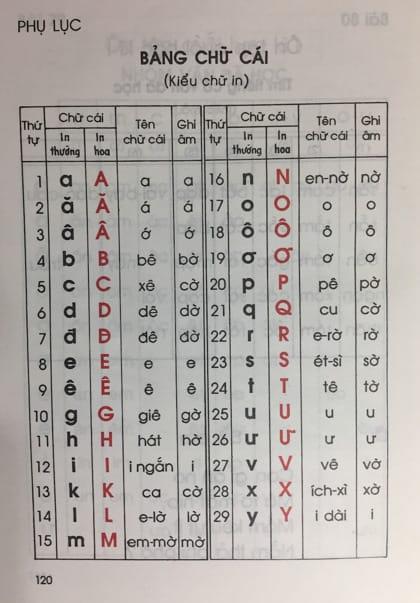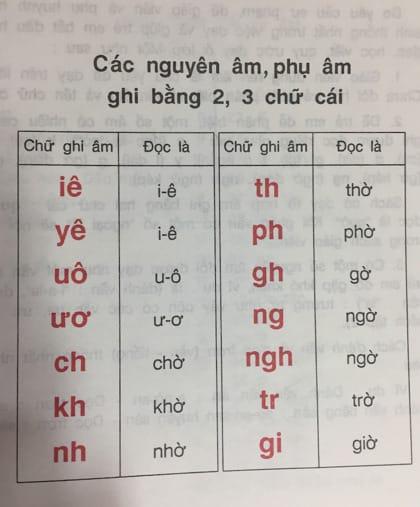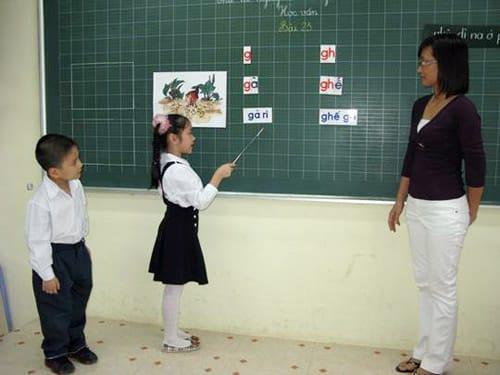Spelling learning - Writing is a system of symbols to record written language, the description of language through symbols or symbols. The writing in each language is made up of the unique alphabet of that language. For every language learner, getting used to the alphabet used for that language is very important first.
Some concepts must be clearly defined before learning to spell:
Word is the smallest unit of language, because many letters and signs combine, have meaning and are used to put into sentences. WORDS include Single Words and Compound Words (Double Words or Double Words).
FROM THE APPLICATION: father, grandmother, grandfather, mother.
COMPOSITION WORDS consists of two words that combine: family, slow, progress.
SOUND or LANGUAGE: smallest pronunciation unit in language.
Rhyme: The main part that makes up the sound of words.
SPELLING: (spelling) is used to WRITE, read the names of the words in the correct order of writing in the word with accents (if the word has accents)
SOUND (pronunciation) is used for READ: connecting sounds, reading quickly, to make them out loud. The purpose is to help students read Vietnamese correctly and quickly.
1. Distinguish letter names and letter sounds
In Educational Technology, students need to clearly distinguish sounds from words. Sound is real thing, sound. The word is a substitute, used to record and fix the sound. Accordingly, there is not always a 1-1 correspondence between sounds and words. Usually, a sound is recorded with a letter (a, b, d, đ, e, l, m, ...).
Many of you confuse letter names and letter sounds. For example: The letter b , the name is "calf" , the sound is pronounced "shore".

Spelling book for children in grade 1
Especially, there are 3 letters c (xê), k (ca), q (quy) are read as "flags". According to Mr. Tran Manh Huong, the letter q is not called "cu", but it is called "quy".
For consonants, vowels recorded by 2-3 letters
There are cases where a sound is not recorded with only one word but can be 2, 3, 4 words; therefore, there should be a spelling law basis. A sound recorded by one word, that is, the phonograms have the same role. Therefore, a sound / wait / is recorded with a ch (letter: wait) rather than being concatenated from the two letters c and h.

How to learn spelling for children
For example: Sound / doubt / is recorded by 2 words: ng and ngh (doubly suspected).
The sound / flag / is recorded with 3 words: c (flag), k (ca) and q (cu).
Audio / ia / is recorded in 4 words: iê, ia, yê, ya
Rhyming chart according to grade 1 educational technology book
a, ă, â, b, ch, e, e, e, g, h, i, kh, l, m, n, ng, th, nh, o, um, e, e, ph, s, t, th, u, uu, v, x, y
Separate sounds: gi; r; d are read as "dumb" but the pronunciation is different.
2. Phonetic characteristics and writing characteristics of Vietnamese
Vietnamese is a single language, these characteristics affect the choice of content and teaching methods.
In terms of phonetics, Vietnamese is a language with many tones, syllables are separated, written separately, easy to identify. On the other hand, the Vietnamese syllable boundary coincides with the phonetic boundary, so most Vietnamese syllables have meaning. Because of this, language (meaning) has been chosen as the basic unit to teach students to read and write in the subject of Literacy.
With this option, right from the first Vietnamese lesson, students have access to a simple language, which is the raw material for simple and complex words in Vietnamese. few hours but I know many words that contain the words that you already know.
In terms of structure, Vietnamese syllables are a tightly organized sound combination, elements in syllables combine with different degrees of tightness: first consonant, rhyme and liquid combination, sets parts in rhyme combine closely. Rhymes play a particularly important role in syllables. This is the basis of how to learn spelling according to the process of spelling (a-fu-am), then combine the first sound with rhyme and tone to make the sound (lo-am-lam-huy-do).

baby learn to spell
3. How to spell 1 hour
Children will learn to spell in a 2-step mechanism:
Step 1: Spell the horizontal sound (when spelling horizontal sounds, separate the first / syllable part).
For example: three: / shore / - / a / - / ba /
Step 2: Spell the sound with bars (when spelled with bars other than horizontal bars: Temporarily split the bar, leaving the crossbar). For example: grandma: / ba / - huyen - / grandma /. Students learn only sound when they are able to read transverse sounds smoothly.
We see a full sound with 3 components: first sound - rhyme - sound, required: rhyme - sound, sound without first sound.
Example 1 . The sound of An has an "an" and a crossbar, without the first sound. Spelling: a - nơ - an.
Example 2. Haunted sound has "am" rhyme and sound tone, without first sound. Spelling: a - fuzzy - am - sharp - dark.
Example 3. Dictionary elected with the first syllable is "b", rhyming "Europe" and the legendary bar. Spelling: shore - Au - Bau - Huyen - elected.
T hí example 4. Russian interference with the first syllable is "nh" rhymed "iêu" and stick down. Spelling: thanks - love - much - fall - noise.
Note: Full rhymes have accompaniment, main sound and end sound.
Example 5. English Nguyen had first syllable as "ng", rhyming "scholarly" and stick down. Rhyme "uyên" has the accompaniment of "u", the main sound is "yê", the last sound is "n". Spelling "uyên" is: u - i - ê - nơ - uyên or u - yê (ia) - nơ - uyên. Spelling "Nguyen" is: doubt - uyên - original - self - nguyen.
Example 6. English Yeng, no initial sounds, rhyming "Yeng" and asked the bar. Rhyme "yiên" has the main sound "yê", the last sound is "ng". Spelling: yiên - asked - yng.
Example 7. English ball with the first syllable is "b", the rhyme is "bee" and timbre. Spell "bee": o - doubt - bee. Spelling "ball" sound: shore - bee - bubble - sharp - shadow.
Example 8. English tilt with the first syllable is "ngh" rhymed "Ieng" and horizontal bar. Rhymes "iánh" has the main sound "iê" and the last sound is "ng". Spelling italics: doubt - ing - italic. This is the language with the most letters of Vietnamese.
Example 9. For a two-word word Fish , we spell each word: flag - on - con - flag - a - ca - sharp - fish.
Example 10. Distinguishing spelling “ da ” (in flesh ) and “ gia ” (in family ).
"Da": da-da-da.
"Gia" sounds completely like "da" but for the sake of spelling it is spelled as: gi (read as di) -a- gia.
So you can completely rest assured about spelling languages according to the educational reform textbook.
Spelling is not purely linguistic but cultural as well. Spelling teaching, literacy has many ways, not just one. The problem is to teach in a way that is suitable for the child's cognitive capacity, simple and effective.
Read more:
Check your child's strengths and how to help them develop them!
Grade 1 - How to help your child stabilize & concentrate in class























